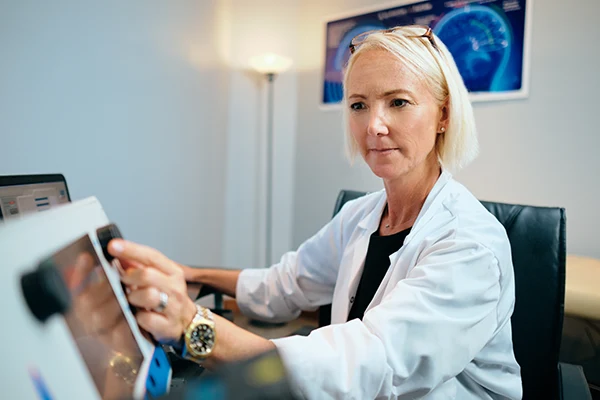In the ever-evolving landscape of healthcare, one of the most remarkable transformations is the integration of software as a medical device (SaMD). It’s a revolution that’s changing how we diagnose, treat, and monitor patients. From improving diagnostic accuracy to enabling personalized treatment plans, SaMD is taking healthcare to new heights. In this blog, we dive deep into software as a medical device and explore its tremendous potential and impact on the healthcare industry.
The Rise of Software as a Medical Device
The rise of SaMD is a testament to the continuous advancements in technology. Over the years, it has evolved from simple applications to complex systems with the power to transform healthcare. The significance of SaMD in modern healthcare cannot be overstated.
- According to a Fact.MR report, The global software as a medical device market, currently valued at $1.1 billion, is projected to reach $5.4 billion by 2032, growing at a CAGR of over 16% from 2022 to 2032
Read Blog: A Look at the Latest Software Development Trends in 2023
SaMD in Diagnostics and Monitoring
- According to a Frontiers in Psychiatry report, SaMD applications in diagnostics have demonstrated diagnostic accuracy levels exceeding 90%, surpassing human capabilities.
- Real-time patient monitoring through wearable SaMD devices can reduce hospital readmissions by 76%, according to a study published in the American Journal of Managed Care.
Moreover, SaMD enables real-time monitoring of patients. Wearable devices and mobile apps equipped with SaMD can track vital signs, detect anomalies, and provide instant feedback. This real-time data can be a game-changer in patient care, especially for those with chronic conditions.
SaMD in Treatment and Therapy
SaMD isn’t limited to diagnostics and monitoring. It plays a crucial role in treatment planning and personalized medicine. With the help of SaMD, healthcare providers can develop treatment plans tailored to individual patients. This level of personalization ensures that patients receive the most effective treatments with minimal side effects.
- According to a National Institute of Health report, Personalized treatment plans developed with the help of SaMD have shown a 33% increase in treatment effectiveness.
Regulatory Framework and Compliance
The development and deployment of SaMD come with significant responsibilities. Ensuring patient safety and data security are paramount. This is where regulatory bodies step in. SaMD is subject to strict regulations to guarantee its effectiveness and safety.
- SaMD is subject to strict regulations, with the FDA regulating medical devices’ safety and effectiveness. Compliance with these regulations is essential to ensure patient safety.
Benefits and Challenges of SaMD
SaMD offers many benefits, but these advantages come hand in hand with unique challenges that necessitate a careful balance. Understanding both sides of the equation is essential for responsible and effective implementation:
Benefits of SaMD:
- Enhanced Diagnostics:
SaMD has significantly improved diagnostic accuracy, often surpassing human capabilities. These tools can rapidly process vast patient data and provide precise diagnostic insights. For example, machine learning algorithms can analyze medical images with extraordinary accuracy.
- Personalized Treatment:
SaMD enables the development of personalized treatment plans. By analyzing a patient’s unique health data and history, healthcare providers can create tailored interventions that offer the most effective treatment with minimal side effects. Personalization leads to better patient outcomes and satisfaction.
- Real-Time Monitoring:
SaMD empowers real-time patient monitoring through wearable devices and mobile apps. These devices can track vital signs, detect anomalies, and provide instant feedback to patients and healthcare providers. Real-time monitoring is particularly valuable for patients with chronic conditions, allowing early intervention and reducing hospital admissions.
- Data-Driven Decision-Making:
SaMD generates a wealth of data that can be leveraged for data-driven healthcare. These insights can inform clinical decision-making, policy development, and medical research. As the volume of patient data grows, the potential for breakthroughs and innovative treatments increases.

Challenges of SaMD:
- Data Privacy and Security:
SaMD devices collect and transmit sensitive patient data. Ensuring data privacy and security is paramount. There’s a constant challenge in safeguarding this data from breaches, unauthorized access, or misuse. Complying with data protection regulations like HIPAA is essential but can be complex.
- Regulatory Compliance:
SaMD is subject to stringent regulatory requirements to ensure its safety and effectiveness. Developing compliant software, maintaining documentation, and navigating the regulatory landscape can be time-consuming and costly. Failure to meet these regulations can result in significant legal and financial consequences.
- Interoperability:
The healthcare ecosystem comprises diverse software and hardware systems. Ensuring seamless integration and interoperability with various electronic health record (EHR) systems and medical devices is a considerable challenge. Lack of interoperability can hinder the adoption of SaMD in clinical settings.
- Ethical and Legal Considerations:
The development and use of SaMD raise ethical and legal questions. Issues such as consent for data use, patient autonomy, and liability for software errors need to be addressed. The ethical use of AI algorithms in SaMD is an ongoing debate.
- Technical Challenges:
SaMD needs to function reliably and accurately. Developing software that can withstand hardware failures or data discrepancies is complex. Ensuring the performance of SaMD across various platforms and network conditions is a significant technical challenge.
- Cost and Resource Allocation:
Developing and implementing SaMD requires substantial time, money, and human resources. The challenge is to manage these costs while keeping healthcare services affordable and accessible.
Conclusion
In the current year of 2023, software development is a dynamic field, continuously pushing the boundaries of innovation. From the ever-expanding world of Artificial Intelligence to the democratization of software development through low-code and no-code platforms, we’re experiencing a tech ecosystem that redefines industries and how we interact with technology. These trends are interconnected, creating a vibrant environment for innovation and collaboration. As we navigate the software development landscape of 2023, we’re embracing a future full of exciting possibilities. The journey has just begun, and the software development world has never looked more promising.
As we celebrate the 30th anniversary of Konverge Digital Solutions, we are proud to be industry leaders in software development. With a team of knowledgeable developers, we continue to drive innovation in SaMD and various other technology fields. The future holds incredible opportunities, and we’re excited to be a part of this transformative journey. Contact us to book a free consultation today





